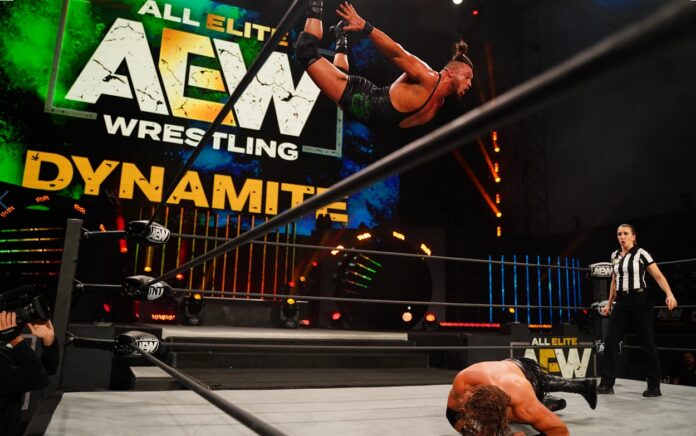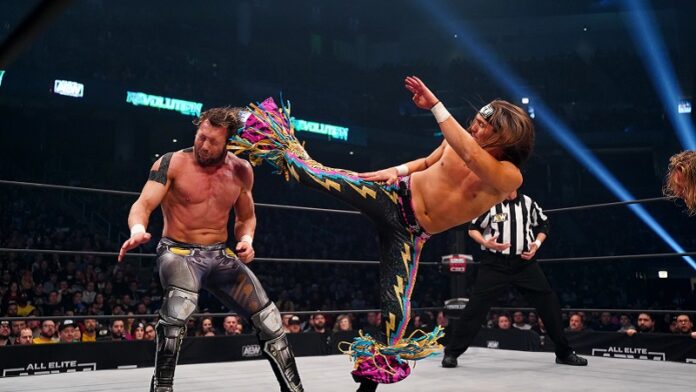AEW stands for All Elite Wrestling. It has existed since 2019, when Tony Khan, Shad Khan’s son, started a new wrestling venture alongside the internationally-known tag team The Young Bucks, Kenny Omega, and Cody Rhodes, son of the late American Dream, Dusty Rhodes. The company began by putting together a couple of pay-per-view events, but they soon got their own TV deal on the TNT network.
Since then, they have steadily grown. They have AEW Dynamite, their flagship show, which airs on Wednesday night at 8:00. Over the past year, they’ve had to run their shows exclusively at Daily’s Place in Jacksonville, the semi-open-air pavilion that’s part of the Jacksonville Jaguars complex.
AEW stands in stark contrast to the WWE and their “sports entertainment” wrestling brand. That’s mainly because AEW is a TV-14 wrestling product, meaning they can cuss, make sexual references, and, most critically, they can show blood. They’ve been doing that a lot lately.
Let’s talk about what blood means in professional wrestling and the cons and pros of using it as part of a company’s branding effort.
Contents
A Harder-Edged Wrestling Promotion

Before too long, AEW is going to go back out on the road. Touring should revitalize the brand, and that has not been possible since the pandemic began over a year ago.
AEW can probably split time between indoor arenas in states that have loosened their pandemic-related attendance policies and outdoor ones in states that are clinging to more stringent safety practices. Outdoor arenas do present some marketing opportunities, if nothing else. AEW might partner with a company like EZ-Up, for instance, that prints custom graphics and logos on canopy tents selling various products.
The fans in attendance will quickly remember what’s different about AEW versus attending WWE shows. AEW often shows blood in their matches. In fact, they seem to go out of their way these days to feature it on almost every one of their cards in at least one match.
It can be a little jarring for some wrestling fans to turn on Dynamite on TNT in primetime and see a wrestler “wearing the crimson mask,” as the legendary Dean of Professional Wrestling, Gordon Solie, once dubbed it. It’s not something that the WWE has dared to show, at least on cable TV, not for many years.
It Wasn’t Always This Way

The WWE was not always a TV-PG product like they are now. They switched over from TV-14 to PG about a decade ago. They knew they were going to come out with an IPO. When they went public, Vince McMahon wanted to go from a more credible wrestling company to the “sports entertainment” model.
Vince’s brainchild once featured blood, just like AEW does now. Wrestling fans can think back to the WrestleMania 13 match between Bret Hart and “Stone Cold” Steve Austin. Austin was gushing blood from a head wound by that match’s end, and it helped to make him a superstar. He won the WWF championship for the first time shortly after that.
Why Blood in Matches?

Someone who is not a wrestling fan might wonder why matches should ever feature blood at all. The answer is that blood usually brings some added drama along with it. It’s hard not to find a match more compelling if blood from a head wound drenches an individual.
There are two ways wrestlers bleed in matches. The first is if they “gig” themselves, meaning they use a small piece of razor blade they hid somewhere in their ring attire, and they cut themselves with it while the camera isn’t on them. Thus, it looks like the other wrestler busted them open by running them into the ring post, hitting them with a chair, and so forth.
The second way is if a wrestler bleeds “the hard way,” meaning that they legitimately collided with a sharp object or their opponent botched a move, and they unintentionally hurt themselves. Hard way bleeding incidents are often more severe than intentional blading.
Does Blood Help the AEW Product?
The reason AEW is rising to prominence is that the WWE had completely taken over the wrestling landscape, and some fans wanted an alternative to what they saw as a homogenized PG product with no hard edge to it. You can’t get away with much of anything if you have a PG-rated TV product and you’re a publicly traded company.
AEW can take more risks than WWE can, and showing blood on TV is part of that. However, you could argue that now, AEW is leaning into that difference more and more.
They had a match on TV recently that they literally called a “Blood and Guts” match, where they virtually guaranteed excessive blood loss by multiple wrestlers, and they delivered. A few months ago, they had an equally grizzly match between NWA import Thunder Rosa and AEW Women’s Division mainstay Dr. Britt Baker.
Ultimately, the question becomes whether AEW hurtling profanity and showing blood on each one of their broadcasts hurts or helps the product. There’s no clear answer to that. It’s probably safe to say that some fans like it, while others would prefer that the company focus on other ways to produce drama, like logical, coherent storylines that pay off with satisfying babyface victories and heel losses.
One thing is certain, though: WWE won’t show blood, cuss, or say anything remotely risqué on their shows, while AEW leans hard in the other direction, as much as their TV-14 rating allows. AEW is also drawing pretty solid rating numbers, indicating that there does seem to be a fan base who likes what they’re selling. The company just announced they’re going to move over to TBS in a few months and add a second show alongside Dynamite.
Some fans are probably always going to like family-friendly wrestling, if there is such a thing, while others want to see the carnage. At least in this particular era, either option is readily available.
















